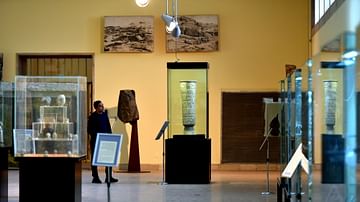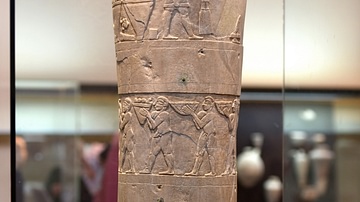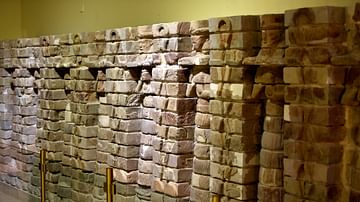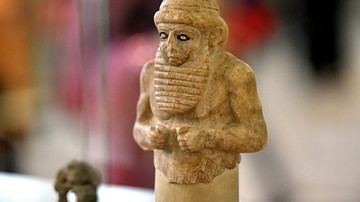Server Costs Fundraiser 2024
Illustration
This is the first almost complete and life-size depiction of the human face in history, with respect to its anatomical details. It is made of marble and is about 20 cm tall. The eyes may have been inlaid with shells and lapis lazuli. The head might have been part of a large cult statue or it was attached to a wall. It may represent the Sumerian goddess Inanna (Akkadian Ishtar). It was excavated by a German archaeological team in 1939 CE, in a temple dedicated to Inanna at the Sumerian city of Uruk (modern-day Warka), southern Iraq, and has been in the Iraq Museum since then. Shortly before the US-led invasion of Iraq in March 2003 CE, the mask of Warka was removed from its display case and was stored in Room 104 of the Museum for safekeeping. Somewhere between April 10 to 12, 2003 CE, it was looted from the Museum after the fall of Saddam's regime. In September 2003 CE, a tip from an informant to the US Military police was received, which said that it was in a farm north of Baghdad. A raid was conducted by the US army and found the Mask of Warka after digging 15 cm in the dirt. It is now on display in the Iraq Museum in Baghdad, Sumerian Gallery. It dates back to Jemdet Nasr period, 3000-2900 BCE.
About the Author
Cite This Work
APA Style
Amin, O. S. M. (2019, March 21). The Mask of Warka at the Iraq Museum. World History Encyclopedia. Retrieved from https://www.worldhistory.org/image/10265/the-mask-of-warka-at-the-iraq-museum/
Chicago Style
Amin, Osama Shukir Muhammed. "The Mask of Warka at the Iraq Museum." World History Encyclopedia. Last modified March 21, 2019. https://www.worldhistory.org/image/10265/the-mask-of-warka-at-the-iraq-museum/.
MLA Style
Amin, Osama Shukir Muhammed. "The Mask of Warka at the Iraq Museum." World History Encyclopedia. World History Encyclopedia, 21 Mar 2019. Web. 27 Jul 2024.




![Warka Vase [Bottom Register]](https://www.worldhistory.org/img/c/p/360x202/10536.jpg?v=1599153304)

![Warka Vase [Middle Register]](https://www.worldhistory.org/img/c/p/360x202/10597.jpg?v=1599154203)

